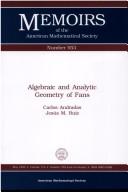| Listing 1 - 2 of 2 |
Sort by
|

ISSN: 00659266 ISBN: 0821826123 Year: 1995 Publisher: Providence (R.I.): American Mathematical Society
Abstract | Keywords | Export | Availability | Bookmark
 Loading...
Loading...Choose an application
- Reference Manager
- EndNote
- RefWorks (Direct export to RefWorks)
Algebraic geometry --- Algebraic topology --- Semialgebraic sets. --- Semianalytic sets. --- Ensembles semi-algébriques. --- Ensembles semi-analytiques. --- Semialgebraic sets --- Semianalytic sets --- Semi-analytic sets --- Geometry, Algebraic --- Set theory

ISBN: 0817640002 9780817640002 3764340002 1461273781 1461220084 Year: 1997 Volume: 150 Publisher: Boston ; Basel ; Berlin : Birkhäuser,
Abstract | Keywords | Export | Availability | Bookmark
 Loading...
Loading...Choose an application
- Reference Manager
- EndNote
- RefWorks (Direct export to RefWorks)
Real analytic sets in Euclidean space (Le. , sets defined locally at each point of Euclidean space by the vanishing of an analytic function) were first investigated in the 1950's by H. Cartan [Car], H. Whitney [WI-3], F. Bruhat [W-B] and others. Their approach was to derive information about real analytic sets from properties of their complexifications. After some basic geometrical and topological facts were established, however, the study of real analytic sets stagnated. This contrasted the rapid develop ment of complex analytic geometry which followed the groundbreaking work of the early 1950's. Certain pathologies in the real case contributed to this failure to progress. For example, the closure of -or the connected components of-a constructible set (Le. , a locally finite union of differ ences of real analytic sets) need not be constructible (e. g. , R - {O} and 3 2 2 { (x, y, z) E R : x = zy2, x + y2 -=I- O}, respectively). Responding to this in the 1960's, R. Thorn [Thl], S. Lojasiewicz [LI,2] and others undertook the study of a larger class of sets, the semianalytic sets, which are the sets defined locally at each point of Euclidean space by a finite number of ana lytic function equalities and inequalities. They established that semianalytic sets admit Whitney stratifications and triangulations, and using these tools they clarified the local topological structure of these sets. For example, they showed that the closure and the connected components of a semianalytic set are semianalytic.
Differential geometry. Global analysis --- Semialgebraic sets --- Semianalytic sets --- Topology. --- Algebraic geometry. --- Algebraic topology. --- Mathematical logic. --- Geometry. --- Algebraic Geometry. --- Algebraic Topology. --- Mathematical Logic and Foundations. --- Mathematics --- Euclid's Elements --- Algebra of logic --- Logic, Universal --- Mathematical logic --- Symbolic and mathematical logic --- Symbolic logic --- Algebra, Abstract --- Metamathematics --- Set theory --- Syllogism --- Topology --- Algebraic geometry --- Geometry --- Analysis situs --- Position analysis --- Rubber-sheet geometry --- Polyhedra --- Algebras, Linear --- Semianalytic sets. --- Semialgebraic sets. --- Geometry, Algebraic --- Semi-analytic sets --- Géométrie algébrique --- Géométrie algébrique --- Espaces analytiques
| Listing 1 - 2 of 2 |
Sort by
|

 Search
Search Feedback
Feedback About
About Help
Help News
News